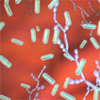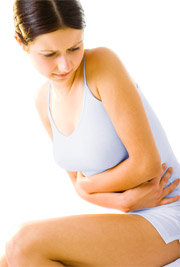- What is vaginal thrush?
- Statistics on vaginal thrush
- Risk factors for vaginal thrush
- Progression of vaginal thrush
- Symptoms of vaginal thrush
- Clinical examination of vaginal thrush
- How is vaginal thrush diagnosed?
- Prognosis of vaginal thrush
- Treatment of vaginal thrush
- Vaginal thrush prevention
- References
What is vaginal thrush?
Vaginal thrush (or vulvovaginal candidiasis) is a common condition that is often chronic and can interfere with women’s sexual function and sense of wellbeing. It is associated with vulvitis (inflammation of vulva) and vaginitis (inflammation of vagina).
It is a type of fungal infection – a yeast infection – caused most commonly by the fungus Candida albicans (in over 90% of cases). Although C. albicans is part of the normal flora that lives in the mouth, throat, intestine and vagina, it may become pathogenic and cause symptoms such as vaginal discharge and pruritis (itchiness) of the vulva. This occurs when the normal environment of the vagina changes as a result of several precipitating factors such as pregnancy, use of antibiotics, diabetes mellitus, HIV, chronic debilitating disease etc which in turn allows the fungus to multiply to abnormal levels and causes the signs and symptoms of vaginal thrush.
Other types of fungi which can cause thrush include C. glabrata, C. tropicalis, C. krusei and C. parapsilosis. These fungi tend to cause recurrent vaginal thrush and are resistant to commonly used antifungal drugs.
Statistics of vaginal thrush
Thrush is a common condition and it is estimated that three out four women, i.e. 75%, will develop the infection in their lifetime and half of these will have repeat infections of one or two episodes. Another 5% will suffer from recurrent thrush, which is having four or more infections a year.
Thrush is less common in girls before puberty and post menopausal women. It is common in women of reproductive age group between 20–40 years and therefore reproductive hormones, particularly oestrogen, is thought to enhance the proliferation and attachment of Candida to the vaginal inner lining. Occasionally however, thrush can occur in post menopausal women if they have uncontrolled diabetes, hormone replacement therapy (HRT), severe chronic disease or if they use antibiotics, immuosuppressive agents or tamoxifen (a breast cancer drug).
Thrush is very common in pregnant women as a result of high levels of reproductive hormones. It is not thought that it poses any risk to the foetus though.
Risk factors for vaginal thrush
Candida is part of the normal vaginal flora along with other organisms in a controlled balance. For some unknown reasons, if the vaginal environment changes, the Candida flourish, proliferate to large numbers, colonise the vagina and become pathogenic causing the signs and symptoms of thrush.
As discussed above, oestrogen, a reproductive hormone is thought to play an important role in increasing the risk of having pathogenic fungal colonisation since thrush is more common in women of reproductive age group of between 20–40 years than in prepubertal girls and postmenopausal women who have lower levels of this hormone. On the other hand, more VVT is seen in post menopausal women who have been put on Hormonal Replacement therapy (HRT) to counter menopausal symptoms and in women on the combined oral contraceptive.
Certain conditions are known to be associated with recurrent thrush. These factors include use of antibacterial and systemic corticosteroids and conditions which affect immunologic status including uncontrolled diabetes, lupus, thyroid disease and HIV infection.
Some behavioural factors such as sexual practices (oral and anal sex), clothing habits and diet are also thought to trigger thrush episodes. It also occurs more frequently in pregnant women.
Progression of vaginal thrush
Most cases of thrush resolve spontaneously when the normal flora recolonise the vagina. Localised thrush responds well to antifungal medication in most cases apart from some 5% of cases which become recurrent and are resistant to common antifungals. These recurrent cases of thrush are commonly caused by other strains of Candida i.e. C. glabrata.
Symptoms of vaginal thrush
Symptoms of thrush generally include:
- Itching of the vulva;
- vulva may be sore;
- vaginal discharge which is white curd-like and cheesy;
- pain during vaginal sexual intercourse;
- and pain when urinating.
Symptomatic thrush can be categorised as uncomplicated or complicated. Uncomplicated thrush occurs sporadically in healthy women and is mild and caused by C.albicans. On the other hand, complicated thrush is recurrent, becomes more severe, occurs in women who are immunocompromised and is caused by non-albicans Candida.
Clinical examination of vaginal thrush
On examination by the doctor, the vulva will look inflamed, reddish, the skin will look torn as a result of scratching and there will be a characteristic whitish cheesy curd-like discharge. In severe cases, the vulva may appear swollen.
How is vaginal thrush diagnosed?
Women who try to self diagnose themselves with thrush have been found to be wrong 66% of the time. Since the signs and symptoms of thrush are non-specific, they are frequently confused with other more common causes of vaginitis such as Bacterial vaginosis (BV). Therefore, women with symptoms of VVT should go to see their doctor for further evaluation.
Their doctor may do the following investigations to ascertain the diagnosis of thrush:
- check the vaginal pH (acidity);
- take a vaginal swab (sample of discharge) for light microscopy (to see the fungi);
- take a biopsy of the lesions;
- take a culture;
- do a DNA probe to detect the presence of Candida species’ DNA.
Prognosis of vaginal thrush
The prognosis is good and most women with thrush will respond to antifungal treatment. In some instances, such as in immunocompromised women and those with poorly controlled diabetes thrush may result in a more severe disease with widespread systemic fungal infection.
Treatment of vaginal thrush
Treatment of thrush involves the use of antifungal creams, vaginal pessaries and/or oral medication. Many of these treatments are now available over the counter (no prescription required). Women who choose to self-treat with over the counter thrush preparations should see their doctor if symptoms persist or recur as they may have a different condition (e.g. bacterial vaginosis, dermatitis, lichen sclerosis, genital herpes) or a resistant strain of thrush. Recurrent thrush infections (those that have been confirmed by a doctor) may require a longer course of treatment before they go away.
In view of the fact that only 34% of self diagnosis and self medication of thrush in women is correct and the rest are incorrect diagnoses, women should consult their doctor before they try to instigate treatment.
Uncomplicated VVT
Uncomplicated VVT responds to many available antifungal drugs such as clotrimazole cream, pessaries or fluconazole oral tablets. Other medications that can be used for uncomplicated VVT include miconazole, econazole, and nystatin available as cream or vaginal pessaries.
Complicated VVT
Recurrent VVT
On the other hand, complicated VVT requires more evaluation and most of the time does not respond to routine antifungal treatment and if it does, it requires a longer period of treatment. For example, in recurrent VVT, fluconazole oral medication (150 mg) is given once weekly for 6 months to prevent recurrence of the infection.
VVT in pregnancy
In pregnant women, oral antifungal medication is contraindicated because of the toxic effect to the baby and instead vaginal pessaries or cream should be used.
VVT in immunocompromised persons
For VVT caused by fungus other than C.albicans, nystatin cream for seven to forteen days is useful. Immunocompromised individuals with VVT require routine antifungal treatment but for seven to forteen days.
Sexual partner treatment
Treatment of the sexual partner is not necessary unless they show symptoms of thrush.
Alternative treatments
Alternative modes of treatment such as oral consumption of lactobacilli in yoghurt, use of tea tree oil, dietary modification (elimination of high sugar foods and foods containing yeast) have not been proven to prevent or treat thrush and should therefore not be self-prescribed without first seeing you doctor.
When should you see your doctor quickly?
A women should promptly see her doctor if she:
- Is a first-time sufferer whose thrush has not previously been diagnosed by a physician;
- Is younger than sixteen or older than 60 years of age;
- Has had at least two episodes of thrush in the past six months but has not consulted her GP about the condition for more than a year;
- Has a previous history of sexually transmitted infection or has been exposed to a partner with one;
- Is or might be pregnant as this restricts the treatments available;
- Has foul-smelling vaginal discharge;
- Has abnormal or irregular vaginal bleeding or blood-stained discharge;
- Has pain in the lower abdomen;
- Has experienced an adverse reaction to antifungal products;
- Has pain on urination (although this is rare with thrush); or
- Has vulval or vaginal sores, ulcers or blisters. These are more commonly associated with herpes infections.
Vaginal thrush prevention
The following measures can help to prevent thrush:
- Wear loose pants or skirts and cotton underwear. Tight or synthetic clothes stop air flow providing a moist area, which is ideal for bacteria and fungi to grow;
- Always wash your hands after you have been to the toilet and before touching the vaginal area;
- Always wipe yourself from front to back after going to the toilet;
- Don’t have vaginal sex straight after anal sex. Wash thoroughly after anal sex and use a new condom and water based lubricant before vaginal sex;
- Wash the genital area with water only. After washing, gently wipe the area dry;
- Avoid soaps or sprays in the genital area, as they can cause irritation;
- Thrush can be passed on through sex. Always use condoms, dental dams and water based lubricant when having sex to avoid this and other sexually transmitted infections;
- Optimal control of blood sugar in women with diabetes;
- Wash underwear in hot water (to destroy fungi);
- Maintain a strong immune system by eating a well-balanced diet, getting enough sleep, not smoking and managing stress levels;
- If prescribed antibiotics for a health complaint, ask the doctor about also taking anti-fungal preparations in combination as a preventative measure.
More Information
 |
For more information view Dr Joe’s video on Thrush. |
References
- Gibbs RS, Karlan BY, Haney AF. Nygaard IE. Danforth’s Obstetrics & Gynecology (10th edition). Baltimore, MD: Lippincott Williams & Wilkins; 2008. [Book]
- Fortner KB, Szymanski LM, Fox HE, Wallach EE. Johns Hopkins Manual of Gynecology and Obstetrics (3rd edition). Philadelphia, PA: Lippincott Williams & Wilkins; 2007. [Book]
- McGarry KA, Tong IL. 5 Minute Consult: Clinical Companion to Women’s Health (1st edition). Philadelphia, PA: Lippincott William & Wilkins; 2007. [Book]
- An update on vulvovaginal candidiasis. MeReC Bulletin. 2004;14(4):13-16, [Full text]
- Decherney AH. Pernoll ML. Current Obstetrics & Gynecology & Diagnosis & Treatment (10th edition). New York: McGraw-Hill; 2006. [Book]
- Vulvovaginal candidiasis [online]. Vancouver: BC Centre for Disease Control; 1 April 2010 [cited 16 December 2010]. Available from URL link
- Diseases characterized by vaginal discharge [online]. Atlanta, GA: Centers for Disease Control and Prevention; 12 April 2007 [cited 16 December 2010]. Available from URL link
- Sheary B, Dylan L. Recurrent vulvovaginal candidiasis. Aust Fam Physician. 2005;34(3):147-50. [Abstract]
- Sobel J, Faro S, Force RW, et al. Vulvovaginal candidiasis; Epidemiologic, diagnostic, diagnosis and therapeutic considerations. Am J Obstet Gynecol. 1998;178(2):203-11. [Abstract]
- Beuters TGM, Dhont MA, Temmermen MIL, Nelis HJ. Prevalence of vulvovaginal candidiasis and susceptibility to fluconazole. Am J Obstet Gynecol. 2002;187(3):569-74. [Abstract]
- Mardh P, Rodrigues A, Gench M, et al. Facts and myths on recurrent vulvovaginal candidosis: A review on epidemiology, clinical manifestations, pathogenesis and therapy. Int J STD AIDS. 2002;13:522-39. [Abstract]
- Fidel PL, Barousa M, Espinosa T, et al. An intravaginal live candida challenge in humans leads to new hypotheses for the immunogenesis of vulvovaginal candidiasis. Infect Immun. 2004;72(5):2939-46. [Abstract | Full text]
- National Guidelines on the management of vulvovaginal candidiasis [online]. London: British Association for Sexual Health and HIV; 14 June 2007 [cited 16 December 2010]. Available from URL link
- Sonnex C, Lefort W. Microscopic features of vaginal candidiasis and their relation to symptomatology. Sex Transm Infect. 1999;75(6):417-9. [Abstract | Full text]
- Sobel JD. Vaginitis. N Engl J Med. 1997;337:1896-1903. [Abstract]
- Schorge JO, Schaffer JI, Halvorson LM, Hoffman BL, Bradshaw KD, Cunningham FG. Williams Gynaecology. New York: McGraw-Hill; 2007. [Book]
- Thrush [online]. Perth: Department of Health, Western Australia; August 2008 [cited 16 December 2010]. Available from URL link
- Watson MC, Grimshaw JM, Bond CM, Mollison J, Ludbrook A. Oral versus intra-vaginal imidazole and triazole antifungal treatment of uncomplicated vulvovaginal candidiasis (thrush). BJOG. 2002;109(1):85-95. [Abstract | Full text]
- Denning DW. Fortnightly review: Management of genital candidiasis. BMJ. 1995;310:1241–4. [Abstract]
- Hopwood V, Crowley T, Horrocks CT, et al. Vaginal candidosis: Relation between yeast counts and symptoms and clinical signs in non-pregnant women. Genitourin Med. 1988;64(5);331-4. [Abstract | Full text]
- Thrush and other vaginal infection [online]. Brisbane: Women’s Health Queensland Wide; July 2009 [cited 16 December 2010]. Available from URL link
All content and media on the HealthEngine Blog is created and published online for informational purposes only. It is not intended to be a substitute for professional medical advice and should not be relied on as health or personal advice. Always seek the guidance of your doctor or other qualified health professional with any questions you may have regarding your health or a medical condition. Never disregard the advice of a medical professional, or delay in seeking it because of something you have read on this Website. If you think you may have a medical emergency, call your doctor, go to the nearest hospital emergency department, or call the emergency services immediately.










